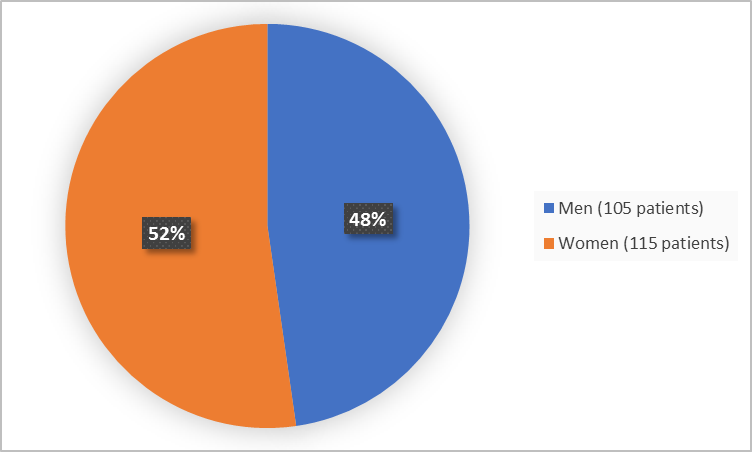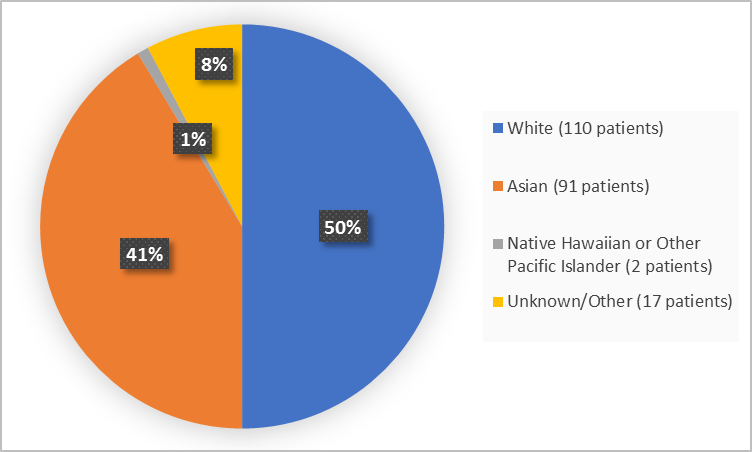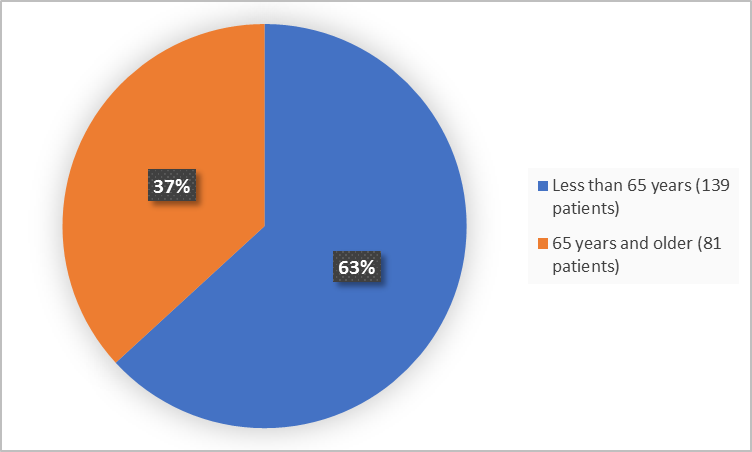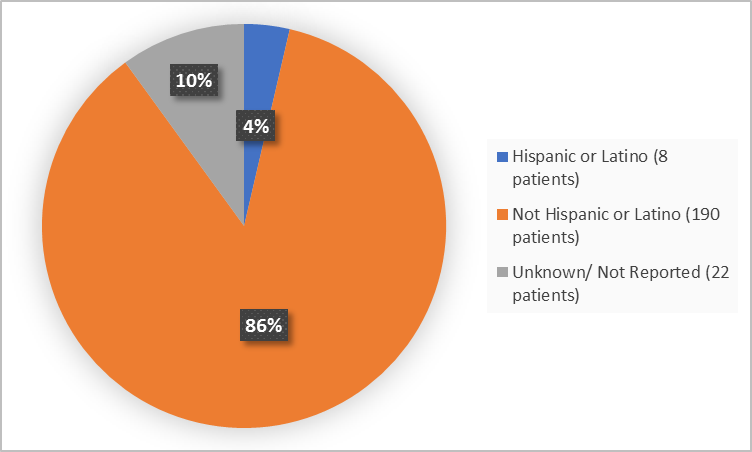Drug Trial Snapshot: GAVRETO
HOW TO USE THIS SNAPSHOT
The information provided in Snapshots highlights who participated in the clinical trials that supported the FDA approval of this drug, and whether there were differences among sex, race and age groups. The “MORE INFO” bar shows more detailed, technical content for each section. The Snapshot is intended as one tool for consumers to use when discussing the risks and benefits of the drugs.
LIMITATIONS OF THIS SNAPSHOT:
Do not rely on Snapshots to make decisions regarding medical care. Always speak to your health provider about the risks and benefits of a drug. Refer to the GAVRETO Package Insert for complete information.
GAVRETO (pralsetinib)
(gav-REH-toh)
Blueprint Medicines Corporation
Approval date: September 4, 2020
DRUG TRIALS SNAPSHOT SUMMARY:
What is the drug for?
GAVRETO is a drug used to treat adult patients with non-small cell lung cancer (NSCLC) which has spread to other parts of the body (metastatic) and is caused by abnormal RET (rearranged during transfection) genes.
How is this drug used?
GAVRETO is a capsule. Four capsules (400 mg) are taken by mouth once a day on an empty stomach.
What are the benefits of this drug?
Fifty-seven percent of 87 patients with previously treated NSCLC experienced complete or partial shrinkage of their tumors. Shrinkage lasted more than 6 months for 80% of them. Out of 27 patients who had never undergone treatment, 70% experienced complete or partial shrinkage of their tumors. Shrinkage lasted more than 6 months for 58% of them.
GAVRETO was approved under FDA’s accelerated approval program, which provides earlier patient access to a promising new drug while the company continues to conduct clinical trials to confirm that the drug works well.
What are the benefits of this drug (results of trials used to assess efficacy)?
The tables below summarize efficacy results based on overall response rate as determined by a Blinded Independent Review Committee (BIRC) according to Response Evaluation Criteria in Solid Tumors (RECIST) v1.1.
Table 1. Efficacy Results for Metastatic RET Fusion-Positive NSCLC Previously Treated with Platinum Chemotherapy
|
Efficacy Parameter |
GAVRETO |
|---|---|
|
Overall Response Rate (ORR)a (95% CI) |
57 (46, 68) |
|
Complete Response, % |
5.7 |
|
Partial Response, % |
52 |
|
Duration of Response (DOR) |
(N=50) |
|
Median, months(95% CI) |
NE (15.2-NE) |
|
Patients with DOR ≥ 6-monthsb, % |
80 |
Table 2. Efficacy Results in Treatment-Naïve Metastatic RET Fusion-Positive NSCLC
|
Efficacy Parameter |
GAVRETO |
|---|---|
|
Overall Response Rate (ORR)a (95% CI) |
70 (50, 86) |
|
Complete Response, % |
11 |
|
Partial Response, % |
59 |
|
Duration of Response (DOR) |
(N=19) |
|
Median, months (95% CI) |
9.0 (6.3, NE) |
|
Patients with DOR ≥ 6-monthsb, % |
58 |
NE = not estimable; CI=confidence interval
aConfirmed overall response rate assessed by BICR
bCalculated using the proportion of responders with an observed duration of response at least 6 months or greater
GAVRETO Prescribing Information
Were there any differences in how well the drug worked in clinical trials among sex, race and age?
- Sex: GAVRETO worked similarly in men and women.
- Race: GAVRETO worked similarly in White and Asian patients. Differences among other races could not be determined because of the small number of patients of other races.
- Age: GAVRETO worked similarly in patients below and above 65 years of age.
Were there any differences in how well the drug worked in clinical trials among sex, race, and age groups?
The table below summarizes overall response rate by sex, race and age subgroups. Results should be interpreted with caution given the small sample size overall and the limited number of patients in each subgroup.
Table 3. ORR as Assessed by BIRC per RECIST 1.1 in Demographic Subgroups
|
Demographic Subgroup |
Prior Platinum Treatment |
Treatment Naïve |
||
|---|---|---|---|---|
|
Responders/n |
ORR (95% CI) |
Responders/n |
ORR (95% CI) |
|
|
Sex |
||||
|
Women |
29/43 |
67 (51, 81) |
11/14 |
79 (49, 95) |
|
Men |
21/44 |
48 (32, 63) |
8/13 |
62 (32, 86) |
|
Race |
||||
|
White |
30/46 |
65 (50, 79) |
10/16 |
62 (35, 85) |
|
Asian |
15/30 |
50 (31, 69) |
7/9 |
78 (40, 97) |
|
Other |
5/11 |
45 (17, 77) |
2/2 |
100 (16, 100) |
|
Age |
||||
|
< 65 years |
36/55 |
65 (51, 78) |
12/13 |
92 (64, 100) |
|
≥ 65 years |
14/32 |
44 (26, 62) |
7/14 |
50 (23, 77) |
FDA Review
What are the possible side effects?
GAVRETO may cause serious side effects including lung inflammation, increased blood pressure, liver toxicity, bleeding, impaired wound healing and harm to an unborn baby.
The most common side effects of GAVRETO are tiredness, constipation, joint and muscle pain, and increase in blood pressure. The most common laboratory abnormalities are increased liver enzymes, increased creatinine and decreased blood counts.
What are the possible side effects (results of trials used to assess safety)?
The tables below summarize adverse reactions and laboratory abnormalities that occurred in patients with NSCLC treated with 400 mg GAVRETO once daily.
Table 4. Adverse Reactions (≥ 15%) in Patients Who Received GAVRETO
|
Adverse Reactions |
GAVRETO |
|
|---|---|---|
|
Grades 1-4 |
Grades 3-4 |
|
|
General |
||
|
Fatigue1 |
35 |
2.3* |
|
Pyrexia |
20 |
0 |
|
Edema2 |
20 |
0 |
|
Gastrointestinal |
||
|
Constipation |
35 |
1* |
|
Diarrhea3 |
24 |
3.2* |
|
Dry Mouth |
16 |
0 |
|
Musculoskeletal Disorders |
||
|
Musculoskeletal Pain4 |
32 |
0 |
|
Vascular |
||
|
Hypertension5 |
28 |
14* |
|
Respiratory, thoracic and mediastinal |
||
|
Cough6 |
23 |
0.5* |
|
Infections |
||
|
Pneumonia7 |
17 |
8 |
1 Fatigue includes fatigue, asthenia
2 Edema includes edema peripheral, face edema, periorbital edema, eyelid edema, edema generalized, swelling
3 Diarrhea includes diarrhea, colitis, enteritis
4 Musculoskeletal pain includes back pain, myalgia, arthralgia, pain in extremity, musculoskeletal pain, neck pain, musculoskeletal chest pain, bone pain, musculoskeletal stiffness, arthritis, spinal pain
5 Hypertension includes hypertension, blood pressure increased
6 Cough includes cough, productive cough, upper-airway cough syndrome
7 Pneumonia includes pneumonia, atypical pneumonia, lung infection, pneumocystis jirovecii pneumonia, pneumonia bacterial, pneumonia cytomegaloviral, pneumonia haemophilus, pneumonia influenza, pneumonia streptococcal
*Only includes a Grade 3 adverse reaction
Table 5. Select Laboratory Abnormalities (≥ 20%) Worsening from Baseline
|
Laboratory Abnormality |
GAVRETO |
|
|---|---|---|
|
Grades 1-4 |
Grades 3-4 |
|
|
Chemistry |
||
|
Increased AST |
69 |
1.1 |
|
Increased ALT |
46 |
2.1 |
|
Increased creatinine |
42 |
1.1 |
|
Increased alkaline phosphatase |
40 |
1.1 |
|
Decreased calcium (corrected) |
29 |
2.2 |
|
Decreased sodium |
27 |
3.2 |
|
Decreased phosphate |
27 |
9 |
|
Hematology |
||
|
Decreased hemoglobin |
54 |
5 |
|
Decreased lymphocytes |
52 |
20 |
|
Decreased neutrophils |
52 |
10 |
|
Decreased platelets |
26 |
0 |
GAVRETO Prescribing Information
Were there any differences in side effects among sex, race and age?
- Sex: The occurrence of side effects was similar in men and women.
- Race: The occurrence of side effects was similar between White and Asian patients. Differences in side effects among other races could not be determined because of the small number of patients of other races.
- Age: The occurrence of side effects was similar between patients below and above 65 years of age.
Were there any differences in side effects of the clinical trials among sex, race, and age groups?
Tables 6-8 summarize adverse events that occurred in sex, race and age subgroups. Presented below is the drug development population consisting of all patients who received GAVRETO at the recommended dose.
Table 6. Subgroup Analysis of Adverse Events by Sex
|
|
Women |
Men |
|---|---|---|
|
Patients with TEAEs |
198 (99.5) |
237 (99.2) |
|
Patients with TEAEs Grade ≥3 |
135 (67.8) |
159 (66.5) |
|
Patients with Serious TEAEs |
93 (46.7) |
102 (42.7) |
Table 7. Subgroup Analysis of Adverse Events by Race
|
|
White |
Asian |
All Others |
|---|---|---|---|
|
Patients with TEAEs |
255 (99.6) |
146 (99.3) |
34 (97.1) |
|
Patients with TEAEs Grade ≥3 |
177 (69.1) |
94 (63.9) |
23 (65.7) |
|
Patients with Serious TEAEs |
122 (47.7) |
53 (36.1) |
20 (57.1) |
Table 8. Subgroup Analysis of Adverse Events by
|
|
< 65 years |
≥ 65 years |
|---|---|---|
|
Patients with TEAEs |
304 (99.0) |
131 (100) |
|
Patients with TEAEs Grade ≥3 |
187 (60.9) |
107 (81.7) |
|
Patients with Serious TEAEs |
116 (37.8) |
79 (60.3) |
TEAE=treatment-emergent adverse event
Adapted from FDA Review
WHO WAS IN THE CLINICAL TRIALS?
Who participated in the clinical trials?
The FDA approved GAVRETO based on the evidence from one clinical trial (NCT03037385) which included 220 patients 26-87 years old with NSCLC caused by abnormal RET genes. The trial was conducted at sites in the United States, Europe and Asia.
All 220 patients that provided data for the assessment of side effects of GAVRETO (safety population) are presented below. Some of these patients provided data for the assessment of the benefits of GAVRETO. Demographic data of these patients that formed efficacy populations are presented in Table 10 under MORE INFO 5.
Figure 1 below summarizes by sex how many patients were in the clinical trial.
Figure 1. Demographics by Sex (safety population)
Adapted from FDA Review
Figure 2 summarizes the percentage of patients in the clinical trial by race.
Figure 2. Demographics by Race (safety population)
Adapted from FDA Review
Figure 3 below summarizes the percentage of patients in the clinical trial by age.
Figure 3. Demographics by Age (safety population)
Adapted from FDA Review
Figure 4. Demographics by Ethnicity (safety population)
Adapted from FDA Review
Who participated in the trials?
Table 9 below summarizes demographics for the patients who received at least one dose of GAVRETO (safety population). Efficacy populations are presented in Table 10.
Table 9. Demographics of Patients in the Clinical Trial (safety population)
|
|
GAVRETO |
|---|---|
|
Sex |
|
|
Women |
115 (52) |
|
Men |
105 (48) |
|
Race |
|
|
White |
110 (50) |
|
Asian |
91 (41) |
|
Native Hawaiian or Other Pacific Islander |
2 (0.9) |
|
Unknown |
15 (7) |
|
Other |
2 (0.9) |
|
Age (years) |
|
|
Mean (SD) |
59 (12) |
|
Median (min, max) |
60 (26 - 87) |
|
Age Group |
|
|
<65 years |
139 (63) |
|
>=65 years |
81 (37) |
|
Ethnicity |
|
|
Hispanic or Latino |
8 (3.6) |
|
Not Hispanic or Latino |
190 (86) |
|
Unknown |
16 (7) |
|
Not Reported |
6 (2.7) |
|
Region |
|
|
US |
58 (26) |
|
Europe |
76 (35) |
|
Asia |
86 (39) |
Adapted from FDA Review
Table 10. Efficacy Population for Metastatic RET-Fusion Positive NSCLC
|
Demographic Parameter |
GAVRETO |
|
|---|---|---|
|
Prior Platinum |
Treatment |
|
|
Sex, n (%) |
||
|
Women |
43 (49) |
14 (52) |
|
Men |
44 (51) |
13 (48) |
|
Race n (%) |
||
|
White |
46 (53) |
16 (59) |
|
Asian |
30 (35) |
9 (33) |
|
Native Hawaiian or other Pacific Islander |
0 (0) |
1 (3.7) |
|
Unknown |
9 (10) |
1 (3.7) |
|
Other |
2 (2.3) |
0 (0) |
|
Age (years) |
||
|
Mean (StdDev) |
59.2 (10.7) |
60.8 (13.8) |
|
Median (min, max) |
60 (28, 85) |
65 (30, 87) |
|
Age group n (%) |
||
|
< 65 years |
55 (63) |
13 (48) |
|
≥ 65 years |
32 (37) |
14 (52) |
|
Ethnicity n (%) |
||
|
Hispanic or Latino |
5 (6) |
1 (3.7) |
|
Not Hispanic or Latino |
67 (77) |
25 (93) |
|
Not Reported |
6 (7) |
0 (0) |
|
Unknown |
9 (10) |
1 (3.7) |
FDA Review
How were the trials designed?
The benefits and side effects of GAVRETO for metastatic NSCLC caused by abnormal RET genes were evaluated in one clinical trial. Some patients were previously treated for their cancer and some were not (treatment-naïve). All patients received GAVRETO by mouth once a day until either cancer progression or intolerable side effects.
The benefit of GAVRETO was evaluated by measuring the percentage of patients who achieved complete or partial shrinkage of their tumors (overall response rate or ORR) and by measuring the duration of that benefit (duration of response or DoR).
How were the trials designed?
There was one multicenter, open-label, multi-cohort trial that provided data to evaluate safety and the efficacy of GAVRETO in adult patients previously treated with systemic therapy and in treatment-naïve patients with advanced or metastatic RET fusion-positive cancer.
Patients received GAVRETO orally once daily until unacceptable toxicity or disease progression. The major efficacy outcome measure for all cohorts was overall response rate and duration of response as determined by a blinded independent review committee according to RECIST v1.1.
Safety assessment was done on all patients who received at least one dose of GAVRETO.
GLOSSARY
CLINICAL TRIAL: Voluntary research studies conducted in people and designed to answer specific questions about the safety or effectiveness of drugs, vaccines, other therapies, or new ways of using existing treatments.
COMPARATOR: A previously available treatment or placebo used in clinical trials that is compared to the actual drug being tested.
EFFICACY: How well the drug achieves the desired response when it is taken as described in a controlled clinical setting, such as during a clinical trial.
PLACEBO: An inactive substance or “sugar pill” that looks the same as, and is given the same way as, an active drug or treatment being tested. The effects of the active drug or treatment are compared to the effects of the placebo.
SUBGROUP: A subset of the population studied in a clinical trial. Demographic subsets include sex, race, and age groups.




